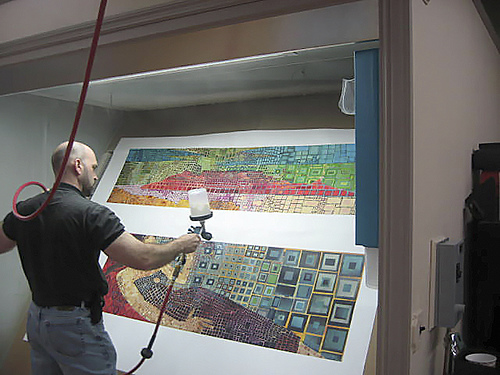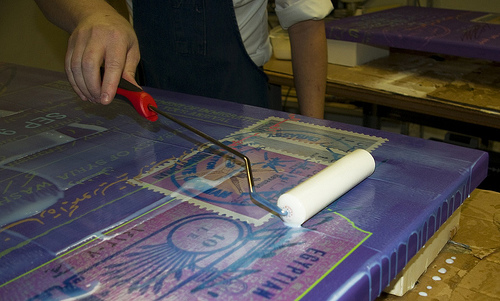 For more than 15 years, LexJet has been helping creators of inkjet prints choose the most cost-effective way to protect valuable prints from damage due to scratching and exposure to UV light, humidity, and airborne pollutants. Photographic and art prints can be protected with traditional framing systems, laminating films, clearcoats, or protective sprays.
For more than 15 years, LexJet has been helping creators of inkjet prints choose the most cost-effective way to protect valuable prints from damage due to scratching and exposure to UV light, humidity, and airborne pollutants. Photographic and art prints can be protected with traditional framing systems, laminating films, clearcoats, or protective sprays.
Protective sprays may be fine if you occasionally make a few smaller prints, but liquid clearcoats are the most popular option for studios that use wide-format pro-model inkjet printers to produce multiple, large photographic and art prints.
LexJet recently introduced Sunset Gloss and Sunset Satin liquid coatings that provide great protection, while taking some of the hassle out of the application process. The coatings are ready to apply straight from the can, without any dilution or mixing. This is important, because every time you add water to a liquid coating, you’re adding an uncontrolled variable that can diminish the level of protection the coating was engineered to provide. The finish of Sunset Gloss and Sunset Satin Coating is tough and flexible, contains UV inhibitors for maximum protection from the elements, and is non-yellowing. The coatings were designed for use with LexJet’s Sunset canvases, but also work well with other canvas products as well as certain photo and fine-art papers.
If you have any questions about using a clearcoat, please contact a LexJet Account Specialist at 888-873-7553 or submit your questions in the comments section of this blog. Below are answers to a few questions we’ve received:
Why do you recommend a liquid coating instead of an aerosol spray?
Aerosol sprays and liquid coatings essentially serve the same purpose—to protect the image. But with aerosol coatings, it’s very difficult to get the correct amount of solids to produce a good protective film. It typically requires more coats to accomplish the same desired result. Liquids are more cost effective, and can either by applied with high-density foam rollers or sprayed on through systems that can be purchased at home-improvement stores. While LexJet sells protective sprays from Hahnemuhle and Clearstar, we currently don’t offer Sunset Gloss or Satin Coatings in spray form.
What’s the best way to apply a liquid coating?
 If I were building a printmaking studio from the ground up, I would include an enclosed, well-ventilated dust-free area in which I could use an industrial HVLP (high-volume, low pressure) spray-gun. An HVLP spray gun wastes less coating in overspray than other types of sprayers. It also provides control over the application process. But since most photographers don’t have room in their studios for spraying (and can’t justify buying specialized coating systems), Sunset liquid coating has been formulated to work equally well when applied either with a spray gun, brush, or foam roller.
If I were building a printmaking studio from the ground up, I would include an enclosed, well-ventilated dust-free area in which I could use an industrial HVLP (high-volume, low pressure) spray-gun. An HVLP spray gun wastes less coating in overspray than other types of sprayers. It also provides control over the application process. But since most photographers don’t have room in their studios for spraying (and can’t justify buying specialized coating systems), Sunset liquid coating has been formulated to work equally well when applied either with a spray gun, brush, or foam roller.
Developing the right technique with a roller can take some practice, and a lot will depend on the temperature and humidity of your work environment. In LexJet’s In Focus newsletter, you can read some helpful tips about rolling on a clearcoat.
 What are the most common causes of errors?
What are the most common causes of errors?
The three most common errors are using incompatible materials, coating the print before it is fully dry, and applying the coating unevenly.
Incompatible materials: LexJet Sunset Coating is a water-based coating. If you apply a water-based clearcoat to inks and papers that aren’t water-resistant, you can easily ruin the print. LexJet sells a wide selection of photo papers, art papers, and canvases that can be protected with LexJet Sunset Coating. A LexJet account specialist can tell you if the combination of ink and materials to use for your prints will work with the LexJet Sunset Coating.
Not waiting long enough for the print to dry before coating it: Different inks dry at different rates, especially if you’re working in an area of the country that experiences wide variations in temperature and humidity. Even when your print feels dry to the touch, it may not be ready to clearcoat. You need to make sure your print has properly “outgassed” before you apply a liquid coating.
Outgassing is the process in which the glycols used as wetting agents in the inks are evaporated. If the glycols haven’t completely outgassed before you apply the coating, your finished print could look cloudy.
To test whether a print has outgassed, some fine-printmakers suggest this technique: Lay each print on a flat surface, then cover the print with inexpensive butcher paper. The evaporating glycols will cause ripples to appear in the butcher paper. Periodically replace the wavy butcher paper with a fresh sheet of paper. If no waves appear in the fresh sheet of paper after a few hours, the print has probably finished outgassing and will be dry enough to clearcoat.
Applying the coating unevenly: If some areas of the print have a different sheen than others, you most likely applied the coating unevenly.
What are the advantages of clearcoating?
A properly formulated clearcoat can add years to the life your fine photo print or art canvas by protecting it from everyday hazards, such as fingerprints and scratches or exposure to sunlight, humidity, and airborne pollutants.
A glossy clearcoat can enhance the density of the blacks and the vibrancy of the colors in your print. But if you don’t want your finished print to look glossy, try applying a layer of Sunset Gloss, finished with a layer of Sunset Satin. The sheen of the finished print is determined by the sheen of the final coat.
The key to getting the best results is to experiment in your own environment. The self-leveling properties in LexJet Sunset Coating can help you achieve optimal results, but the best techniques for applying Sunset coatings will depend on the specific conditions within your work environment.
If you have any questions or coating techniques you’d like to share, we would welcome your comments!
